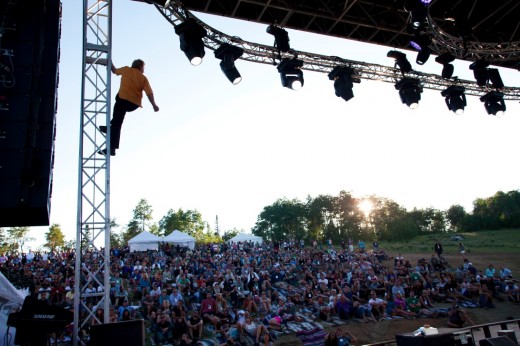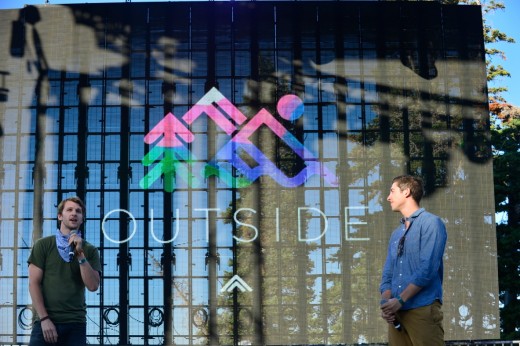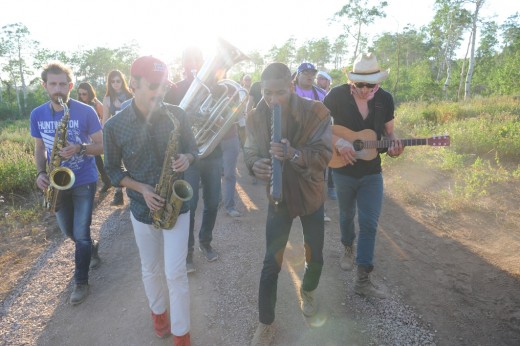Entrepreneurs gather in Eden for the first Summit Outside

Last Friday, my friend Shak pathed, “Productivity at tech companies must be low today. Half the folks are headed to Utah while the other half are looking for an ice cream truck.”
Told to pack for a camping trip but not much else, 850 like-minded individuals showed up in Eden, Utah last Friday for the first Summit Outside event, hosted by the Summit Series team famous for its weekend retreats like Basecamp and Summit-at-Sea. For Outside, attendees were encouraged to disconnect, with the promise of “finding a better connection.”
Without WiFi or outlets, a group of the world’s most Internet-addicted human beings found immense freedom letting go of the digital world and reconnecting with nature.

It was the first major event held in Eden, Utah since the 45-person team purchased Powder Mountain for $40 million earlier this year. Weekend tickets started at $2,000 and went up to $12,000 depending on housing options like a 10-person dome, quad tent or air-conditioned RV.
Summit donated a portion of ticket sales to local nonprofits and attendees made optional donations at registration. In total, Summit Outside raised nearly $100,000 for Ogden Valley and Weber County nonprofits, including the Weber School Foundation, Ogden Valley Land Trust, Weber Pathways, Weber County Fire Officers Association and The Nature Conservancy.
When the mountain purchase was announced, there were several complaints from local townspeople who were dubious of the team’s ability to preserve the mountain’s old-fashioned charm. Change is still a thing you should believe in, as the event drove more than $2 million dollars into the local economy and resulted in over 300 local jobs.

Upon arrival, attendees geared up for the weekend with free Nike Fuelbands, headlights, tin cups and camouflage backpacks for carrying around their new Tom’s sunglasses. After chucking bags into tents and strapping on hiking boots, attendees were delighted by surprises at every turn like a sonic meditation deck, a late-night noodle truck, a flash sale of coconuts and LeWeb founder Loic LeMeur giving office hours in the middle of a forest.

Attendees stopped by the activity tent to sign up for paint ball, hiking, horse-back riding and mountain bike riding – or a knot tying workshop with Philippe Petit, the man featured tightrope-walking between the World Trade Center towers in the documentary Man on Wire.
Somewhat retired, Petit decided to climb the stage at the event’s closing plenary instead.

Each morning on Powder Mountain, we practiced yoga on The Lotus Deck, overlooking Ogden valley. Teachers included Sasha Bahador, Founder of ShaktiLife and Kenneth Von Roenn III, Creator of Skanda Yoga.

Just a 5-minute walk down the hill, Taylor Kuffner’s robotic orchestra, known as “The Gamelatron” was tied to trees in a forest of hammocks, providing an oasis of relaxation for weary Summiteers.

One of the more popular surprises was the Duck Pond, a hedonistic escape from the killer content and outdoor adventure experiences. Aerated and perfectly clean for swimming in, the Duck Pond served as an ideal cool down during the 90 degree days. Summit’s Chief Reconnaissance Officer Thayer Walker says the Duck Pond will be a permanent structure for the years to come.

As entrepreneurs do, the Summit team members are building a permanent community that didn’t exist before, a home they’re proud to live in, and one they can call their own. “Our goal is to create a center of gravity for the innovators, entrepreneurs, and thought-leaders of the world,” says Summit co-founder Jeremy Schwartz, pictured below with fellow co-founder Brett Leve. “We hope Summit Eden will become a community built around a shared ethos that emphasizes collaboration as tool to drive positive, multidisciplinary output.”

Many will compare Summit Series to TED, Davos or even Burning Man, but lining up such energetic entities side-by-side is boring. While there were quite a few speakers at Summit Outside who have also spoken in Long Beach, and people important enough to fly to Switzerland each year, and a lot of dust and dancing in The Electric Forest, what’s more interesting is why events like this exist, and how The Summit Series team has brought such magical experiences to life that are shaping a generation of change-makers.
Content
The Summit Team offered content and activities ranging from a 3-hour mountain biking tour to a discussion of the female hormonal system to an hour-long talk about the recent Trayvon Martin trial. When asked to reflect on a high point from the weekend, Shervin Pishevar, Co-founder and Managing Partner of Sherpa Ventures, answered:
“The Trayvon talk. Cheeraz [Gorman]’s tears opened a flood gate of love and truth. It changed hearts and minds and planted the seeds of a new social justice movement. Our nation still needs a process of reconciliation. There’s too much locked within our hearts. We need to get in that circle we formed in the forest and widen to all so we can all feel what we did that day.”

Humans weren’t the only ones leaving Powder Mountain with new flight patterns. Summit partnered with Earthwings, a raptor nonprofit, to release two rehabilitated birds of prey into the wild at the event.

Summit also partnered with Pack and Pounce, a local animal shelter to create a puppy pen where attendees could adopt puppies destined to be put down. 9 puppies were adopted and saved.

The event could’ve been called the “Summit of Love” – not because of the plethora of mountain-top sessions – but because love was on everyone’s lips, particularly speaker and therapist Esther Perel, who wins the award for giving the most talks in a 48-hour period.
As entrepreneurs, we are used to giving all of ourselves to our companies and careers, then we come home at night with just leftover scraps of our energies for our loved ones. How will we ever have as successful relationships as we do careers if we keep carrying on like this? Esther didn’t have all of the answers, but she made us realize that if its a fulfilling love life we want, we need to explore the possibilities of adjusting our current priorities.

Production
The Summit team’s production talents are extraordinary. On Saturday night, attendees were invited to have dinner around a quarter-mile long picnic table in a field. The walk to dinner was led by jazz musician Jonathan Batiste.

For many photo-takers, this visual feat and delightful feast was a highlight of the weekend.

The Summit team knows how to throw a party too. After dinner, the electronica ensemble Thievery Corporation played a 2-hour set before 50 fans jumped on stage for a late-night dance party. There were all dozens of artists and DJs, like Big Boi, RAC, Sean Glass and DJ Equal, who played until the wee hours of the morning for sparkly-pantsed dancers. To listen to all of the artists who performed this weekend, SoundCloud’s David Noel made a playlist for you.
Curation
While Summit is often knocked for being exclusive, its curated community creates an environment for some of the world’s most ambitious people to open up professionally, emotionally and physically. “It’s going to be a place on Earth that becomes a sacred space for growth and development,” says Nicole Patrice De Member, the Founder of Toi and the woman responsible for introducing Summit to Greg Mauro, the entrepreneur and Eden, UT resident who brought the Powder Mountain opportunity to the team. “The people who need love will end up here. We want the world to be a part of this. It’s not a secret journey, but you still have to go on that journey to get here.”
Summit designed the event with serendipity built-in so that porch-front dinner conversations, afternoon walks down dusty Main Street, or late night discussions in the tea hut became places where we shared journeys of success, failure and personal hardship. “No matter where I went or what I did, I stumbled upon some of the most amazing, interesting people I’ve ever met. It’s a magical experience unlike any other,” says Summit first-timer Ryan Matzner, Fueled’s Director of Strategy.
The first night of Summit Outside I stood next to a stranger as we waited for our camp mates. I said “Hi” and gave him a warm hug the way you might a friend. He said, “Thank you, I really needed that.” He then told me his father had just passed away that morning. And instead of canceling plans to be with his immediate family, he decided that his first step towards healing was to be with his Summit family. In a place so loving, empowering and supportive, I understood.

Summit Outside was the team’s first big event on Powder Mountain – and for most in attendance, those 72-hours were a transformational experience. The Summit Team’s passion shines through everything it touches, and they’ve fortunately chosen to build their home in one of the most beautiful settings on Earth. In Eden, once again, we feel like we’re just at the beginning of it all…
LearnVest wants to fix your poor spending habits, nabs $16.5M to scale its financial planning service

Financial planning startup LearnVest has its heart set on fixing your poor spending habits – and minting money because of them. Now, after polishing its product and launching on the iPhone, LearnVest is gearing up for expansion with a new round of funding: $16.5 million in funding, to be exact, with investments from Accel Partners, American Express Ventures, Claritas Capital and others.
Sitting nicely alongside this news, LearnVest, which offers both a money management app and advising services, is also announcing its first West Coast office. The space, located in Phoenix, will serve as the company’s hub for housing and training financial planners. We’re told LearnVest’s new space will hold about 25 people, and that the company plans to “scale up to a few dozen.”
LearnVest as a company has seen success with its product – according to CEO Alexa von Tobel “the product works; now we’re scaling [it].” Gearing up for this expansion, LearnVest tells us it has new distribution plans in the works, including partnerships with undisclosed companies that offer LearnVest services to their employees.
A “major commercial partnership” is also apparently coming, which could involve American Express, given its fresh stake in LearnVest. We’ll be sure to update you on that deal as news surfaces. Until then, you can check out LearnVest here.
Image credit: Thinkstock
Starbucks adds Duracell Powermat wireless charging stations to its coffee shops in Silicon Valley

Starbucks is quickly becoming the ultimate chain of Internet caf s due to its solid Wi-Fi connectivity, free app vouchers, access to The New York Times website and now, reliable wireless charging.
Following a successful roll-out across Boston, Duracell announced today that it will be fitting the Duracell Powermat in a number of Starbucks stores across the Silicon Valley area. These wireless charging spots are fitted directly to the tables, giving consumers the ability to recharge their various electronic devices while sipping a cup of hot joe.
The caveat, it would seem, is that these charging spots require the user to own a Powers Matters Alliance (PMA) certified device or smartphone case. Duracell sells these independently for the iPhone 4, 4S, 5 and Samsung Galaxy S III, but that seems like an awfully restrictive range of devices – we’ve reached out to the company to see if it’ll support more handsets in the future.
For reference, AT&T announced in April this year that it would be integrating wireless charging within a select number of smartphones by 2014. Blackberry, HTC, LG and Samsung, among others, are also signed up with the PMA.
The selective roll-out in Silicon Valley, combined with the need for a specialist device or case, restricts the scope of the program and how useful it will be to the majority of global Starbucks coffee lovers.
What it does show, however, is a glimpse at how the company wants to expand the in-store Starbucks experience and make it increasingly tempting for people to come in on a regular basis. A fast, stable Wi-Fi connection is now a given for almost any Starbucks store – it’s easy to see how wireless charging could quickly become just as prevalent.
“We know that our customers use our caf s in a number of ways beyond buying coffee. For some, it’s their home office, for others it’s their place to get away and have some time to themselves. More and more customers are using Starbucks as their home base and they are looking to recharge in a number of ways,” said Adam Brotman, chief digital officer, Starbucks Coffee Company.
A similar effect has been achieved inadvertantly in Apple stores – consumers walk in all the time to charge their iPhone or iPad – so Starbucks would be wise to expand the number of stores offering Duracell Powermats as quickly as possible. People increasingly need to charge their smartphones in the middle of the day – we use them more and more with power-hungry apps – so more places to charge will never be unwelcome.
Image Credit: Oli Scarff/Getty Images
T-Mobile cuts upfront smartphone costs in the US, but ramps up monthly payments instead

T-Mobile made a great deal of fuss over its flexible ‘uncarrier’ contracts back in March – clearly separating the cost of the call plan and the handset – but now it’s taking the idea one step further by dropping the upfront cost of the handset altogether.
In what it describes as an “unparalleled” promotion, T-Mobile subscribers will be able to pick up a flagship device such as the HTC One, Samsung Galaxy S4 and iPhone 5 for free. The network operator is then adding most, if not all of the difference to the regular monthly instalments that consumers need to pay to actually own the handset.
There’s some savings to be made here, but it’s essentially just another payment plan. Accept the upfront cost and the user benefits from lower device payments. Forgo the down payment entirely, however, and subscribers have to accept that most of the savings will be added on to their final monthly bill.
As The Verge reports, to put the price difference in perspective the Samsung Galaxy S4 costs $149.99 up-front alongside a $20 monthly fee for two years. Or, a total of $629.99. Under the new $25 tier, with no up-front cost, that comes to $600 exactly. Other handsets, such as the iPhone 5, offer even more negligible discounts.
The promotion is also compatible with T-Mobile’s JUMP! program, enabling consumers to upgrade after six months to a new handset. The catch, however, is that T-Mobile takes subscribers’ existing handsets back, nullifying the payments made up until that point.
“The number of reasons not to switch to T-Mobile this summer is ZERO,” John Legere, president and chief executive officer of T-Mobile US said. “Adding Zero Down in addition to JUMP!, and Simple Choice with no contract is all about making wireless work for consumers and shaking up this industry.”
The scheme is described as a promotion, so it’s fair to assume that it will only run for a short period of time. All of the new monthly payment amounts are listed below – if you’re strapped for cash but looking to switch to a new carrier in the US, this could be a viable option.
- Samsung Galaxy S4 – $25
- Samsung Galaxy Note II – $27
- Samsung Galaxy S III – $22
- Xperia Z from Sony – $25
- iPhone 5 – $27
- Nokia Lumia 925 – $20
- Nokia Lumia 521 – $5
- BlackBerry Q10 – $25
- HTC One – $25
- Samsung Galaxy Tab 2 10.1 – $20
Image Credit: John Moore/Getty Images
New York’s Grand Central – and nine other beautiful train stations | Jason Farago
Jason Farago: The notoriously ugly Penn station has a chance to be reborn, but here are 10 termini which need no beautification at all
Jason Farago

|
|
Bitcoin: more than just the currency of digital vice
Bitcoin, the digital coin with a questionable past, is gaining ground as a legitimate currency, trading at $32 a share last week
Dale doesn’t exactly look like an international crypto-criminal. He’s soft-spoken, baby-faced, and a senior at an Ivy League college. But every couple of weeks the political science major logs onto the Silk Road, an online black market that has been described as an “amazon.com of drugs” to buy wholesale quantities of “molly” (also known as MDMA, a particularly “pure” form of ecstasy), LSD and magic mushrooms. Some of these will be for his personal use, and the rest he’ll flog to less tech-savvy classmates at a mark-up of up to 300%. On a good weekend, he can net a profit of around $2,500. It’s a more lucrative sideline than waiting tables.
While Dale prices his party favours in dollars, he pays for them the only way you can pay for anything on the Silk Road: by using Bitcoins, an untraceable digital currency founded in 2008 by the pseudonymous “Satoshi Nakomoto”. Despite persistent efforts to uncover his identity, little is known about Nakamoto: he’s the Banksy of the internet. Or, rather, he was. Nakomoto disappeared without a trace in 2011, after telling a developer “he’d moved on to other things”. Bitcoin itself, however, shows no signs of vanishing: in the past two months it more than doubled its value against the dollar and after reaching an all-time high last Wednesday, it has been trading at above $32 a share.
Unless you’re a major tech geek or a regular patron of the shadowy computer underworld known as the dark web, you’ve probably never heard of – let alone used – Bitcoins. But below the “real” economy of legal tender and federal reserves, Bitcoins fuel a shadow economy that connects students, drug dealers, gamblers, dictators and anyone else who wants to pay for something without being traced. It has found a niche as the currency of internet vice, digital “pieces of eight” for modern-day pirates.
Despite these unsavoury associations, Bitcoin is increasingly winning a place on the internet as a legitimate currency, albeit one that will probably never quite shake off its dodgy past. Bitcoin is part of a gradual, technological shift in the way we think about money. It poses a tangible threat to centralised banking and the guardians of fiat money. Bitcoin won’t knock off the dollar any time soon; the euro can sleep easy. But it is clearly a force to be reckoned with. Bitcoin has become the world’s best performing currency, with its value spiking 130% just this year.
Bitcoins, unlike the cash you have in your pocket, are finite. There are currently 10.8m Bitcoins in the system, and this will cap out at 21m coins by the year 2140, according to market research firm ConvergEx. Limiting supply has been a major plus for Bitcoins, and a major reason why prices have gone up.
If you want to buy Bitcoins you simply go to an online exchange service such as Bitinstant and convert your local currency into the virtual money. These are then stored in a “wallet”, which functions as a sort of online bank account. You can then go and spend these anywhere that takes Bitcoins to buy anything from socks to drugs.
The Bitcoin network is structured like a guerilla movement: it is decentralised, controlled by its users rather than governments. This means it is (theoretically, at least) anonymous, and that, unlike credit cards and PayPal, which block payments from a number of countries, it enables instant payments to anyone, from anywhere in the world. That’s why criminals love it and why some online retailers do, too. It’s money without any kind of safety net below it. There’s no legislation to protect your investment and you can’t protest fraud.
It’s worth bearing in mind that while Bitcoin operates outside the parameters of governmental control and is often used to dubious ends, so too is a lot of the money we see around us. The US Treasury printed 3bn $100 bills in the 2012 fiscal year and, 80% of them go overseas, according to Federal Reserve estimates. As Nicholas Colas, ConvergEx Group chief market strategist, notes, “many of them simply facilitate the global drug and arms trade, not to mention tax evasion and human trafficking”. Bitcoins fit into the world of real currency more than anyone would like to think.
While governments and legislators have long been waging wars on traditional funny money, they are only just starting to wake up to the effects alternative currencies may have on the financial landscape. In 2011, two Democratic senators, alerted to the thrills of the Silk Road by a Gawker article, wrote to the US attorney general demanding that something be done about Bitcoin. And in October last year, the European Central Bank published a paper that recommended that developments in virtual currencies be regularly examined to reassess the risks.
The association between Bitcoins and drugs is clearest on Silk Road, where the currency is the only method of payment that is accepted. But Dale, the Ivy League student, uses the currency with care – not least because of its volatility. “I try to purchase only as many as I will need for a specific transaction, because they have historically had pretty wild inflation and deflation.”
Dale sees Bitcoins as the glue that binds a certain type of digital trade: “It seems to me like Bitcoins are essential for the currently thriving digital underground economy, but they also represent the beginning of an extra-governmenta, international digital economy.”
Bitcoin isn’t just for petty criminals, however: it has also made its debut in geopolitics. Last year, Iran was cut off from the European and US currency systems. High inflation caused the native currency, the rial, to plummet in value. With no dollars or euros available, Iranians used Bitcoin as a way to gain access to the international currency markets: they bought Bitcoins and later swapped them for dollars through an exchange site like Mt.Gox.
While Bitcoin has so far operated at the margins of the economy, there is some evidence that it is slowly entering the mainstream. WordPress, Reddit, and Megaupload have just started to accept Bitcoins and you can now even buy pizza with them. In December, the currency took its biggest step towards legitimacy yet, after partnering with a payments service provider in France. They also had a booth at this year’s Consumer Electronics Show (CES), which featured a picture of a wholesome looking woman holding an iPhone running a Bitcoin app.
Edward Castronova, a professor of telecommunications at Indiana University Bloomington, who has who pioneered the economic study of virtual worlds, doubts that Bitcoins will ever become a mainstream currency, however. Castronova’s scepticism stems from the way that Bitcoin is structured as a currency with a fixed size. “It just isn’t very fun. We’ve learned from game currencies that people like a little inflation in their economies. But Bitcoin is built to deflate. And we’ve just seen, culturally, people don’t like deflation.”
While it seems unlikely that Bitcoins will ever represent a full-scale challenge to regular money, they point to the rise of virtual currencies and changing definition of currency. Alternative currencies continue to slowly creep in around the edges of the economy: in February, Amazon announced that it is introducing its own custom currency called, rather imaginatively, Coins.
Starting in May, US customers will be able to use Coins to buy apps, games and in-app items on the Kindle Fire, with Amazon giving out “tens of millions of dollars worth of Coins” as a preliminary stimulus package.
And calculations by the Economist in January 2005 suggested that the total stock of unredeemed frequent flyer miles was worth more than all the dollar bills in circulation.
Castronova notes that among young people, the mental accounting on different sorts of “money” is already very fuzzy. “Twenty-year-olds don’t see any difference at all between dollars, gold coins, GPAs,” said Castronova. “They’re all just digital score sheets”.
The future of money may or may not include a Federal Reserve Bank of Amazon, but it probably does involve the gradual decentralisation and democratisation of currency. Virtual currencies aren’t just a new-fangled sort of Monopoly money. Rather, they may just be the thing that ends the monopoly on money.
Thanksgiving 2012 traffic to retail sites up 71% over 2011: Amazon leads, Walmart and Target follow

All those mobile payment increases from PayPal, GSI, and eBay are starting to make sense. Shoppers really were going crazy this year compared to last: Thanksgiving Day online traffic increased 71 percent in 2012 versus 2011.
The top 500 retail sites received more than 181 million total US visits, up from 176 million last year. The holiday week of online traffic to the top retail sites increased a decent 8 percent on average and retail traffic was up 46 percent from Wednesday to Thursday. Experian has the latest numbers, including this interesting breakdown of the top five retail sites:

That chart may be a bit hard to make out, but here’s the point to take home: Amazon dominated, but Walmart was close behind. In fact, Amazon did great both on Wednesday and on Thursday, while Walmart saw significant more traffic on Thanksgiving day than the day before. In fact, the remaining three retail sites saw the same: rounding out the top five, we have Target, Best Buy, and Sears.
It’s hard to say why Amazon didn’t see as big of a jump as its competitors, but it doesn’t really matter as the company still led the pack. Best Buy saw the biggest day-over-day growth at 104 percent, and Sears actually jumped up into the top 5 after ranking 6th the day before.
The biggest disappointment in this data is the following note in the chart: “rankings based on weekly data that does not include mobile traffic.” As mobile becomes more and more important, its impact on retail sites cannot be disregarded. If the data was included, would Amazon still be the top dog?
See also – Thanksgiving breaks Instagram records: Over 10M photos shared at a rate of up to 226 per second and Windows 8 store adds 7,000 apps in two weeks to pass 20,000 mark, almost 18,000 are free
Image credit: Robert Linder




